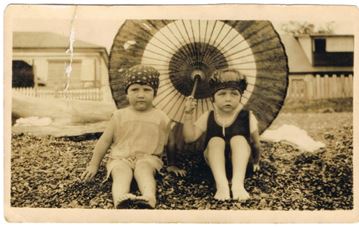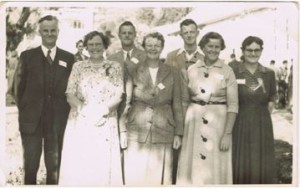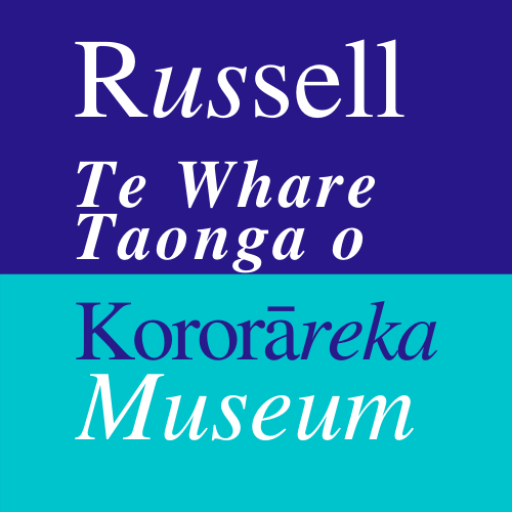Continuing our series of before and after views of Russell, here’s a house that has had many incarnations. It was built in 1869-70, by JL Mandeno, for James White, US Commercial/Consular Agent, and known locally and wrongly, as the American Consul’s house. A consul is an official appointed by the government of one country to look after its commercial interests and the welfare of its citizens in another country – that wasn’t White’s role. He sold his house in 1888. It and the land have had many owners and many occupations since – store, hotel, school, church, motor camp, golf course, race course, farmhouse and family home – now it serves as boutique travellers’ accommodation. Photos clockwise from left: 7302 c. 1950s; 11501 c. 1960s; IMG_1233, 2013. Source.dictionary.reference.com
Tag: heritage
-

Goods For Sale – #150
You’re looking into the waterfront Four Square store in 1997. Maybe it was winter. Maybe in summer there would have been rows of jandals lined up. Back then the middle of the town was still a bit swampy, the domain footy field was a bit wet at one end – customers of all sizes needed good waterproof footwear. Now try to imagine stores over a century earlier. Here’s a hint – from the New Zealand Advertiser and Bay of Islands Gazette of June 19th 1840: Geo. Greenway had for sale at his store near Russell, salt, flour, corks, cordage, canvas, twine, ironmongery, paints, oil &c. &c; John J. Montefiore, of Kopua, Russell, advertised tobacco, Wardell’s sherry in bottle, claret ditto, port and sherry in bulk, vinegar, salt, red and blue shirts, white ditto, stockings, cantoon trousers, blue cloth trousers, vests, prints, ginghams and other articles; while William Wilson begs to acquaint his Friends and the Public, that his store at the Pa is still carried on, where they can be supplied with GOODS of every description. The previous issue had listed his goods as pitch, tar, oakum, butter, paint oil, porter, rice, calicoes, mattresses, sperm oil, ale, spades, biscuit, tobacco, white lead, wine, muskets. All the essentials of life could be found in 1840, in Kororāreka.
Source: http://paperspast.natlib.govt.nz/cgi-bin/paperspast?a=d&d=NZABIG18400619&e=——-10–1—-0–
-

Old Soldiers Never Die… = #151
…when they are model soldiers. They can be restored to their former state, even improved, with some metal primer, new paint and a steady hand. These models, in the 1845 uniform of the Manchester regiment, the 96th Regt. of Foot, were made in moulded lead by a former officer of the same regiment and presented to Russell Museum in 1958. They had begun to show signs of age so we sent them to “Regal Toy Soldiers” in Greytown for a little R&R. The officer bears the regimental colours and is flanked by a sergeant and a private – on the left before restoration and on the right as we received them back in the mail last week. The models will soon be returned to their permanent display space inside the museum.
How are they relevant to us? The Manchester regiment was on duty at the Maiki Hill Flagstaff on March 11th 1845. After the night’s engagement with the forces of Heke, Kawiti and Kapotai, the 96th’s casualties were: killed, Privates Giddens, Ireson, Jackson and Millar; died of wounds, Private Duross; and wounded, Privates Guttridge, Scott and Welton. The five privates are buried near St Paul’s Church in Paihia and commemorated with a bronze plaque. Another plaque on the corner of Church and Robertson Streets, here in Russell, was erected 150 years after the Battle of Kororāreka to remind us to remember the events, and the many other consequences and unnamed casualties of that night’s conflict
Source. History of the Manchester Regiment (Late the 63rd and 96th Foot). Vol 1 1758-1883. Compiled by Colonel H.C. Wylly C.B. 1923. p 221.
-

Busy Campers – #152
Two views – huts in the forties, for soldiers, and canvas tents in the fifties for families and holidaymakers. The Russell Domain has been the temporary home for many thousands of summer visitors, but the 2nd Battalion 3rd Auckland Regiment was here in the winter too. The Aucks, as they were known, moved to Russell in late June ’42. The country was preparing for invasion by Japanese troops in the Pacific. In addition to sentry duties, and controlling the telephone exchange during the night, while they were stationed here the Aucks built the road that is named after them. Six days a week, from 7am till 4pm they were out there with minimal machinery, and picks and shovels, securing a supply route to the town. Fortunately it never had to be used for its other purpose – the removal of guns, if retreat ever became necessary. The Aucks had a peaceful sojourn here in Russell, just like the campers who followed them.
-

Hinemoa & Tūtānekai – #153
Coincidence, synergy or synchronicity? Destiny maybe? Call it what you will, there is something going on which makes you wonder. Following the bequest of a significant collection of the work of Pauline and James Yearbury five years ago we have been searching out and acquiring their wooden panels. The latest of these, Hinemoa and Tūtānekai is now on display in the Marie King Gallery. It is the first panel we have seen that depicts historical figures rather than mythical ones. It returned to Russell last week, from the US, where it had been since being bought here in the 1970s. The story of these two courageous lovers is a well known one, but not, surely a local one? Hinemoa’s legendary swim was across the waters of Lake Rotorua, from Owhata to Mokoia Island, guided by the sounds of Tūtānekai ‘s flute. A couple of generations later, one of their descendants was taken captive by Hongi Hika’s 1823 tauā (war party)and brought back to the Bay of Islands. She was not captive for long, marrying Thomas Joyce, and founding a large local family. This family named two of their whaleboats for their famed ancestors. Their whaleboat “Tutanekai” is on display, in its own shelter, in Russell Museum’s grounds. An oar, believed to be from the second whaleboat, “Hinemoa” was found and presented to the museum in 2010. And now we have their images on the wall. But where is the other whaleboat? Is it too, somewhere out there, waiting to be found?
-

Holidays in Hauai – #154
These photos are from an album, bought about ten years ago at an Auckland market, showing a family on holiday. We think it may be the Lawford family. We think it may have been about 1943-45. That’s all we know – except that they seemed to be having a good time, eating good food and enjoying good company, in glorious surroundings. Do I envy them? Yes.
-

Alsatia – Where the law cannot reach – #155
“The country north of Auckland may be most conveniently reached by taking passage in one of the Northern Steamship Company’s fine vessels which, leaving Auckland in the late afternoon, reaches early the following morning the expansive estuary of the Bay of Islands lying between Capes Wiwiki and Brett, eleven miles apart. So spacious is the entrance, and so deep is the water – so free from hidden dangers – that one may enter at will any time and anchor close up to the lovely shores without risk of stranding. It is, in truth, one of the finest harbours in the world…Steaming up the capacious inlet – wherein the navies of Europe may ride in safety – the vessel passes in rapid succession pretty little isles verdurous with foliage and serene in their unbroken repose, while the coast on either side is replete with the unpremeditated embellishments of Nature – sequestered bays, pebbly beaches, ferny dells, woody knolls, and clustering hamlets. While the charms of the bay and its hundred isles hold the attention the vessel rounds a rocky peninsula redundant with vegetation, and directly in her course lies the town of Russell slumbering on the margin of its delightful crescent-shaped bay… as we wander about the streets we tread upon the ashes of Kororareka – of that strange Alsatia of the Pacific where runaway convicts from Australia consorted with hardy whalers, and where nightly orgies and daily brawls disgraced the name of civilisation. At times as many as one hundred and twenty whalers have lain together off its beach, and money was freely spent and little regarded there.” This is how our town and surroundings were perceived in an 1886 publication by a writer who arrived by sea, possibly in the ship shown in the photo, the NSSCo’s Clansman. Here it is tied up to the Russell wharf, on a Friday night c.1920, loading passengers for Auckland .
Source: Picturesque Atlas of Australasia Vol III. pp64-65. Edited by Hon, Andrew Garran. 1886
-

Names and Faces – #156
 No, they are not photos of the same people thirty years apart. On the left Kathleen Williams and an unnamed friend show their style on the Russell beach c.1924 and on the right seven King siblings gather at the Russell School reunion in 1956. Many generations of both King and Williams families have been resident here, and contributed in a myriad of ways to the shape of our village. A great-great-grand daughter of the first Williams in Russell, John and Mary, donated these photos and several others to the museum, following her visit in January. As always, we have more faces than names for these images so if anyone is interested in viewing them and trying to identify people for us, please call in and help us out.
No, they are not photos of the same people thirty years apart. On the left Kathleen Williams and an unnamed friend show their style on the Russell beach c.1924 and on the right seven King siblings gather at the Russell School reunion in 1956. Many generations of both King and Williams families have been resident here, and contributed in a myriad of ways to the shape of our village. A great-great-grand daughter of the first Williams in Russell, John and Mary, donated these photos and several others to the museum, following her visit in January. As always, we have more faces than names for these images so if anyone is interested in viewing them and trying to identify people for us, please call in and help us out. -

Once there was a mill here – #157
1858 was a year notable not only for the erection of the Maiki Hill flagstaff, Whakakotahitanga, but also for the building of a more prosaic structure. This was the year Motu Kaiaraara became known as Mill Island – probably too, the only time that the citizens of Kororāreka formed a company to grow and mill grain. Tourism probably hadn’t quite taken off then. Kaiaraara had its top lopped off and steps were cut in one side – undoubtedly without a resource consent. At this time the island was part of J.S.Clendon’s property. There were high hopes. Grain, mostly oats, was sown on every available slope around Russell and Long Beach but yields were poor. There was never enough to keep the mill working for long. Its location though did serve one of its intended purposes – the mill, unlike buildings on the mainland, was free of rats. After a few years the sails of the windmill were torn off in a storm and never replaced. Time took care of the rest of the ruins. Images of the mill are rare. This etching appeared in two newspapers that we know of, a Paris paper “L’Univers Illustre” published 1858-1900, and the London Illustrated News, which was published weekly 1842 – 1971 and then less regularly until 2003 when it closed.
Sources. Marie King (1992). A Most Noble Anchorage. http://en.wikipedia.org/wiki/The_Illustrated_London_News gallica.bnf.fr/ark:/12148/cb328854407/date
-
Four Fossils – #158
A fish, two coconuts and a rock with embedded fossilized shells. What do they have in common? Two things – they’re all fossils and they’ve all ended up in Russell Museum’s collection. Only one was found here, the fish, at Long Beach. The coconuts are from near Coopers Beach, where they are common, from well known fossil plant beds which were once coastal forest. Like all the others found there, these coconuts are small, about four cm long. The species, Cocos zeylandica, is now extinct but provides evidence of warmer subtropical conditions in Northland, 16-11 million years ago. The shell-embedded rock was found in the Mohaka River, Hawkes Bay, only 60 kms from where Joan Wiffen and others have found fossils of dinosaurs, turtles, pterosaurs and marine reptiles. These date back 200 – 65 million years but the shells are undated. As our islands were almost totally, perhaps completely, underwater until about 25 million years ago, their occurrence far from the ocean is not surprising. The local fish, a similar size to the coconuts, probably lived much more recently. One estimate is that it may be 2 million years old. Just a youngster.

